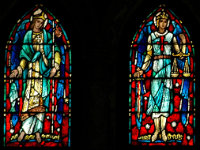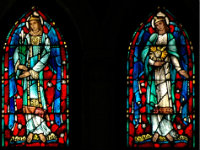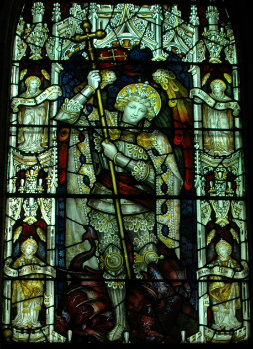Like the architecture, the glazing program at Emmanuel Church was assembled by gradual accretion and is characterized by overall diversity and major transformations in style. The church retains several precious examples of pre-opalescent-era stained glass by native designers.…These surviving examples of native glazing are of unusual importance. Lance Kasparian, 1990
See also: Windows of Lindsey Chapel & World War I Memorial
Photography by Julian Bullitt
Chancel
On left, 2 heralds [and another broken in 2000 fire] were designed by Charles J. Connick (1875-1945, who had a studio in Boston from 1913) based on the earlier design of Charles Eamer Kempe (1837-1907). They were given in memory of George Hawley in 1936.
On right, an archangel flanked by heralds, by Kempe, were given in memory of Anna Saltonstall Merrill Ward in 1902.
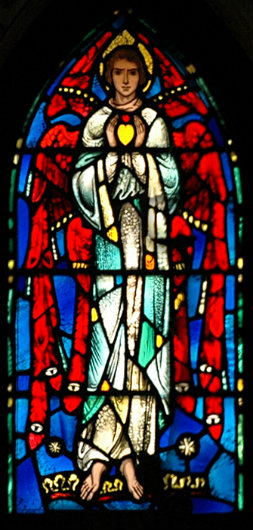 In the center is a red-winged seraph flanked by archangels: Raphael and Michael (on left) with Gabriel and Uriel (on right). Designed by Connick, they were also given in memory of George Hawley in 1936.
In the center is a red-winged seraph flanked by archangels: Raphael and Michael (on left) with Gabriel and Uriel (on right). Designed by Connick, they were also given in memory of George Hawley in 1936.
Clerestory windows by Kempe were given in memory of Jonathan French in 1902. In sets of three, moving from chancel to the chapel, they depict figures from the Hebrew Bible: Abraham, Isaac, Jacob; Joseph, Miriam, Moses; Joshua, Deborah, Samuel; Ruth, David, Solomon; Elijah, Elisha, Micaiah; Hosea, Amos, Micah; Isaiah, Jeremiah, Ezekiel; and Zerubbabel, Ezra, Nehemiah.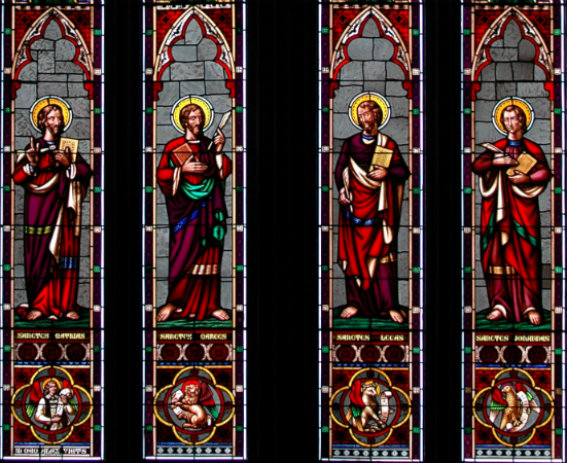
Above the balcony, the Four Apostles Window (detail above), probably designed by Samuel West, was given in memory of Bishop Alexander Viets Griswold (1766-1843) at the time the Church was founded. It was restored in 1999 with a grant from the George B. Henderson Foundation.
Back Wall
The clerestory windows by Kempe, given in memory of John Davis Williams French in 1902, depict sets of New Testament figiures: Apostles Peter, John & Paul; the Centurion of Capernum, the Woman of Samaria & Nicodemus; Evangelists Matthew, Mark & Luke; Disciples Andrew, Philip & Nathaniel; Magi Melchior, Balthasar & Caspar; and a nativity group of St. John the Baptist, the Archangel Gabriel and the Virgin Mary, which will not be visible until the windows are better lit.
By the sacristy, our Burnham Window was given in memory of Marian Burnham (1884-1896), in 1900. Designed by Heaton, Butler & Bayne but damaged in the 2000 fire, it was restored at Serpentino’s Stained Glass Studio in 2016 thanks to a grant from the George B. Henderson Foundation.
Emmanuel Land’s Window depicts an allegorical scene from John Bunyan’s Pilgrim’s Progress: Piety, flanked by Discretion, Prudence and Charity, shows Pilgrim the way to Emmanuel’s Land. Installed when the nave was reoriented in 1898, it was given in memory of Mrs. Howard Payson Arnold, mother of its designer Frederic Crowninshield (1845-1918).
St. Michael Killing the Dragon (detail), designed by Kempe, was given in memory of Frederick Warren in 1901.
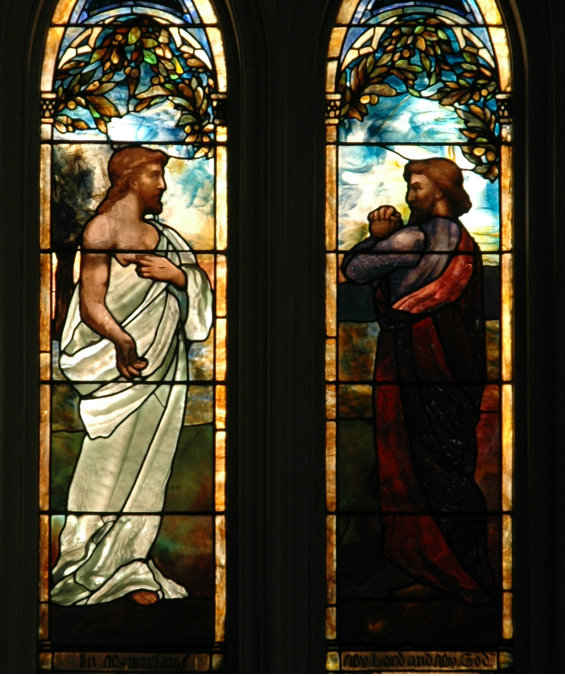 Incredulity of St. Thomas (detail above), designed by the New York firm Tiffany Glass & Decorating Co. (1824-1889), was given in memory of George Augustus Meyer in 1890.
Incredulity of St. Thomas (detail above), designed by the New York firm Tiffany Glass & Decorating Co. (1824-1889), was given in memory of George Augustus Meyer in 1890.
Organ Loft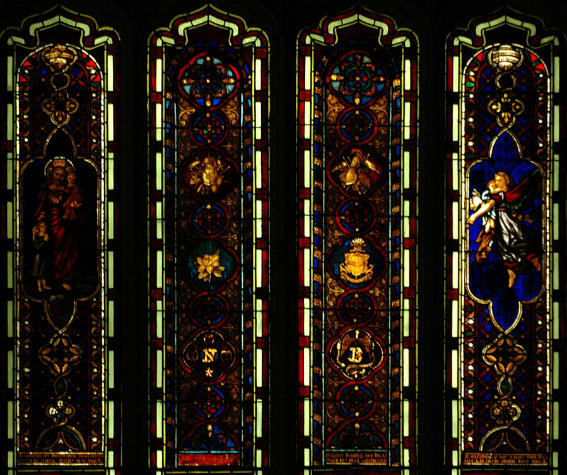
These windows (with footers featured above in the banner image of this page) were given when the Church was founded as memorials to members of the Lawrence, Rand, Bowditch, and Gould families. The central upper panels were designed by abolitionist and public-health pioneer Henry Ingersoll Bowditch and given in memory of his son Lieutenant Nathaniel Ingersoll Bowditch, who died in the Civil War and whose initials can be discerned. Flanking lancets showing Christ with two children (left) and an angel and child (right) were given in memory of Frederic Augustus Gould and Charles Walter Gould. Lancets on the bottom left were given in memory of Eliza Rand. Lancets on the bottom right were given in memory of Amos Lawrence by his son and founder William R. Lawrence.


